1996 CADILLAC SEVILLE key
[x] Cancel search: keyPage 75 of 354
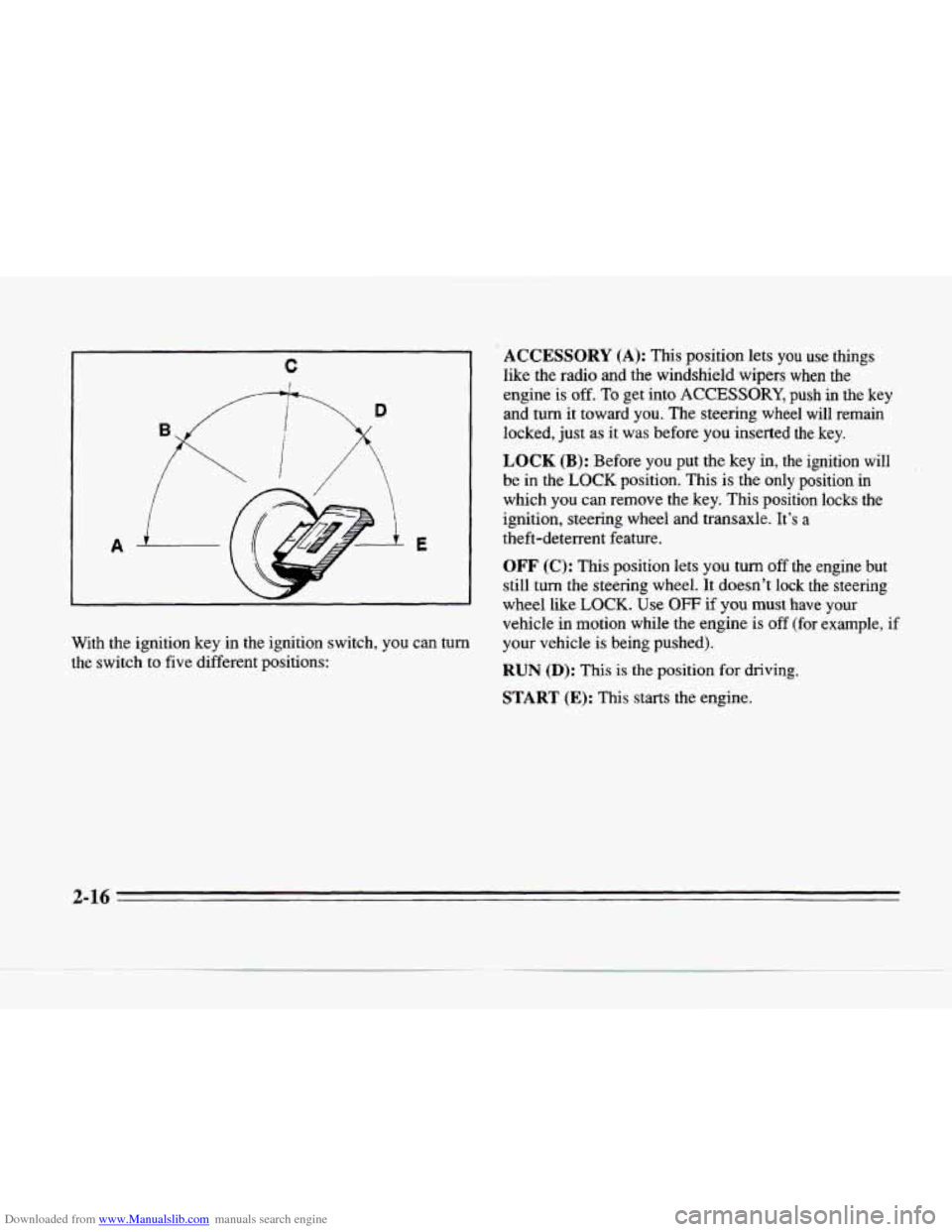
Downloaded from www.Manualslib.com manuals search engine C
I
W
With the ignition key in the ignition switch, you can turn
the switch to five different positions:
ACCESSORY (A): This position lets you use things
like the radio and the windshield wipers when the
engine is
off. To get into ACCESSORY, push in the key
and turn it toward you. The steering wheel will remain
locked, just as it was before you inserted the key.
LOCK (B): Before you put the key in, the ignition will
be in the LOCK position. This is the only position in
which you can remove the key. This position locks the
ignition, steering wheel and transaxle. It’s a
theft-deterrent feature.
OFF (C): This position lets you turn off the engine but
still turn the steering wheel.
It doesn’t lock the steering
wheel like
LOCK. Use OFF if you must have your
vehicle in motion while the engine is off (for example, if
your vehicle is being pushed).
RUN (D): This is the position for driving.
START (E): This starts the engine.
2-16
4
Page 76 of 354
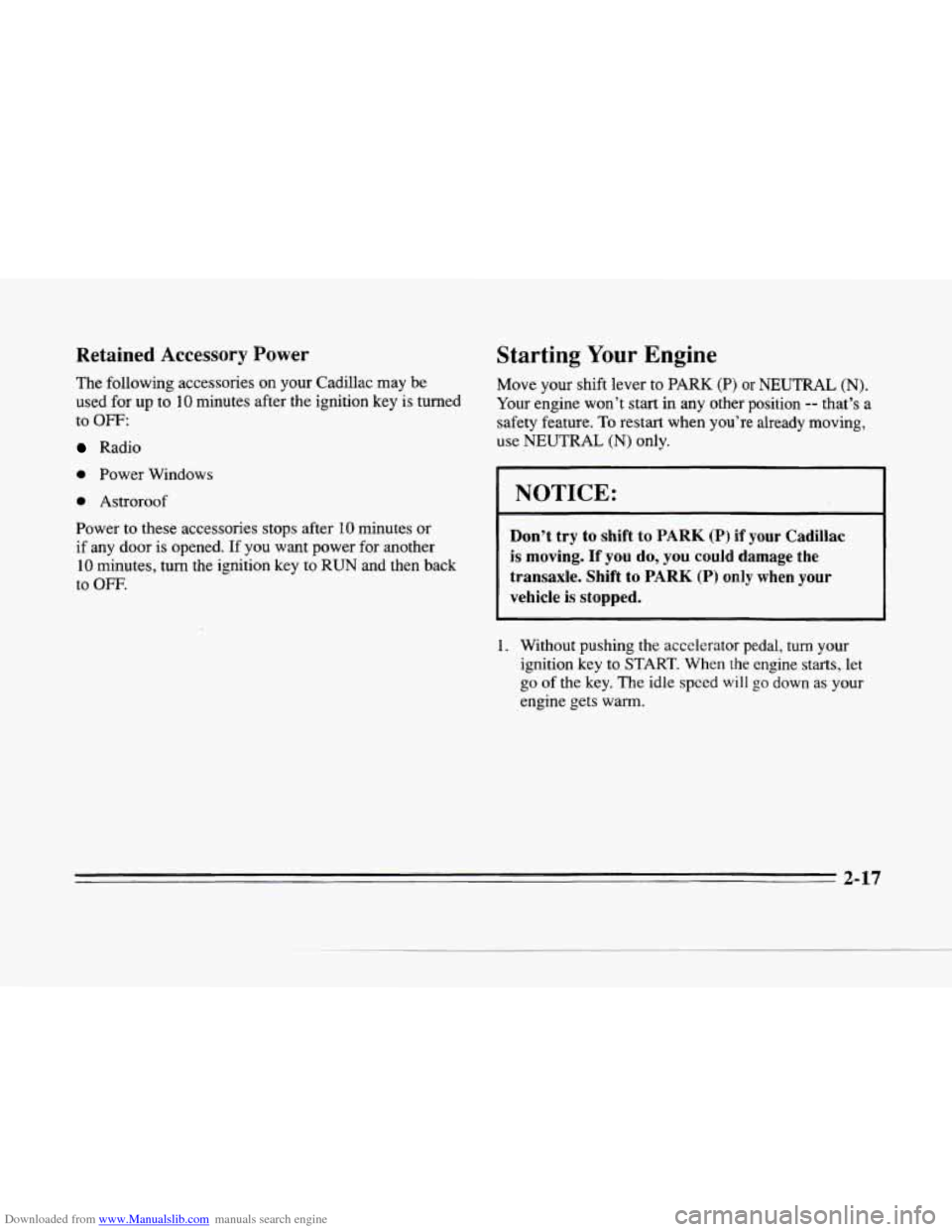
Downloaded from www.Manualslib.com manuals search engine k
Retained Accessory Power
The following accessories on your Cadillac may be
used for up to
10 minutes after the ignition key is turned
to
OFF:
Radio
0 Power Windows
0 Astroroof
Power to these accessories stops after
10 minutes or
if any door is opened. If you want power for another
10 minutes, turn the ignition key to RUN and then back
to
OFF.
Starting Your Engine
Move your shift lever to PARK (P) or NEUTRAL (N).
Your engine won’t start in any other position -- that’s a
safety feature.
To restart when you’re already moving,
use
NEUTRAL (N) only.
=ICE:
Don’t try to shift to PARK (P) if your Cadillac
is moving. If you do, you could damage the
transaxle. Shift to PARK (P) only when your
vehicle is stopped.
1. Without pushing the accelerator pedal, turn your
ignition
key to START. When the engine starts, let
go of the key. The idle speed will go down as your
engine gets
warm.
2-17
Page 77 of 354
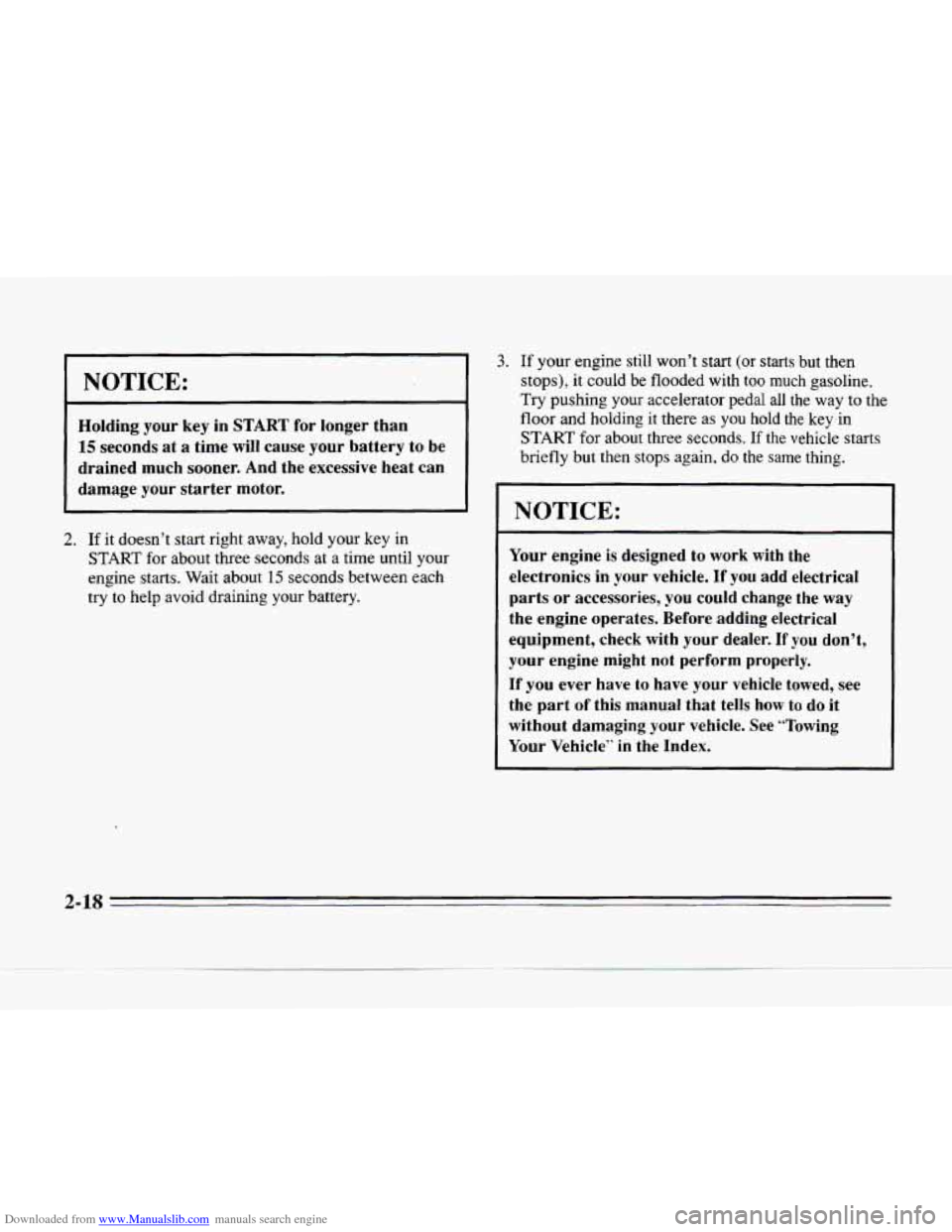
Downloaded from www.Manualslib.com manuals search engine w
NOTICE:
Holding your key in START for longer than
15 seconds at a time will cause your battery to be
drained much sooner. And the excessive heat can
damage your starter motor.
2. If it doesn't start right away, hold your key in
START for about three seconds at a time until your
engine starts. Wait about
15 seconds between each
try to help avoid draining your battery.
3. If your engine still won't start (or starts but then
stops), it could be flooded with
too much gasoline.
Try pushing your accelerator pedal all the way to the
floor and holding
it there as you hold the key.in
START for about three seconds. If the vehicle starts
briefly but then stops again, do the same thing.
NOTICE:
Your engine is designed to work with the
electronics in your vehicle. If you add electrical
parts or accessories, you could change the way
the engine operates. Before adding electrical
equipment, check with
your dealer. If you don't,
your engine might not perform properly.
If you ever have to have your vehicle towed, see
the part
of this manual that tells how to do it
without damaging your vehicle. See "Towing
Your Vehicle'' in the Index.
2-18
Page 80 of 354
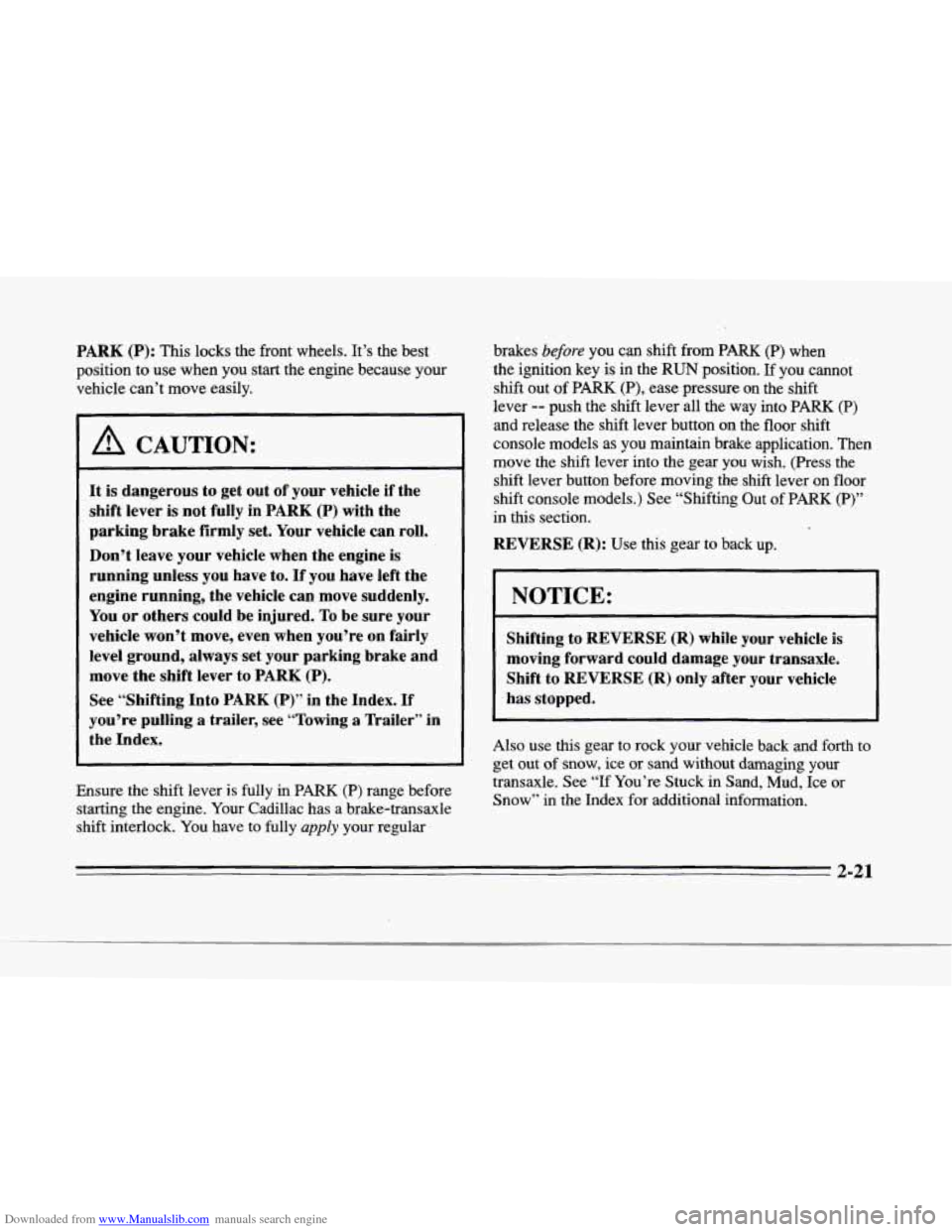
Downloaded from www.Manualslib.com manuals search engine r
I’
i
r“.
f
r.
r
PARK (P): This locks the front wheels. It’s the best
position to use when you start the engine because your
vehicle can’t move easily.
I A CAUTION:
It is dangerous to get out of your vehicle if the
shift lever
is not fully in PARK (P) with the
parking brake firmly set. Your vehicle can roll.
Don’t leave your vehicle when the engine is
running unless you have to.
If you have left the
engine running, the vehicle can move suddenly.
You or others could be injured.
To be sure your
vehicle won’t move, even when you’re on
fairly
level ground, always set your parking brake and
move the shift lever to
PARK (P).
See “Shifting Into PARK (P)” in the Index. If
you’re pulling a trailer, see “Towing a Trailer” in
the Index.
Ensure the shift lever is fully
in PARK (P) range before
starting the engine. Your Cadillac has a brake-transaxle
shift interlock. You have to fully
apply your regular brakes
before you can
shift from PARK (P) when
the ignition key is in the
RUN position. If you cannot
shift out
of PARK (P), ease pressure on the shift
lever -- push the shift lever all the way into PARK (P)
and release the shift lever button
on the floor shift
console models as
you maintain brake application. Then
move the shift lever into the gear you wish. (Press the
shift lever button before moving the shift lever on floor
shift console models.) See “Shifting Out of PARK (P)”
in this section.
REVERSE (R): Use this gear to back up.
NOTICE:
Shifting to REVERSE (R) while your vehicle is
moving forward could damage your transaxle.
Shift to
REVERSE (R) only after your vehicle
has stopped.
Also use
this gear to rock your vehicle back and forth to
get out of snow, ice or sand without damaging your
transaxle. See
“If You’re Stuck in Sand, Mud, Ice or
Snow” in the Index for additional information.
2-21
Page 85 of 354

Downloaded from www.Manualslib.com manuals search engine Steering Column Shift Lever
1. Hold the brake pedal down with your right foot.
2. Move the shift lever into the PARK (P) position
like this:
0 Pull the lever toward you.
0
3.
4.
5.
Move the lever up as far as it will go.
With your right foot still holding the brake pedal
down,
set the parking brake.
Move
the ignition key to LOCK.
Remove the key and take it with you. If you can
leave your vehicle with the
ignition key in your
hand, your vehicle
is in PARK (P).
Console Shift Lever
1. Hold the brake pedal down with your right foot.
2-26
Page 86 of 354

Downloaded from www.Manualslib.com manuals search engine -
--
2. Move the sh.& lever into the PARK (P) position like ths:
. , .. .,#, .. rc; I/,< .. ~ . .. . , . .,. . .. , , ,,, ..I ...-gg . .!.
3. Hold in the button ~fl the leifef ha push the lever all
the way toward the front of your vehicle.
4. With your right foot still holding the brake pedal
down, set the parking brake.
5. Move the ignition key to LOCK.
6. Remove the key and take it with you. If you can
leave your vehicle with the ignition key in your
hand, your vehicle is in
PARK (P).
Leaving Your Vehicle With the Engine
Running
1 A CAUTION:
It can be dangerous to leave your vehicle with
the engine running. Your vehicle could move
suddenly
if the shift lever is not fully in PARK (P)
with the parking brake firmly set. And, if you
leave the vehicle with the engine running, it could
overheat and even catch fire.
You or others could
be injured. Don’t leave your vehicle with the
engine running unless you have to.
If you have to leave your vehicle with the engine
running, be sure your vehicle is in PARK
(P) and your
parking brake
is firmly set before you leave it. After
you’ve moved the shift lever into the PARK
(P)
position. hold the regular brake pedal down. Then, see
if you can move the shift lever away from PARK (P)
without first pulling it toward you (or, if you have the
console shift lever, without first pressing the button).
If
you can. it means that the shift lever wasn’t fully locked
into
PARK (a).
2-27
Page 87 of 354
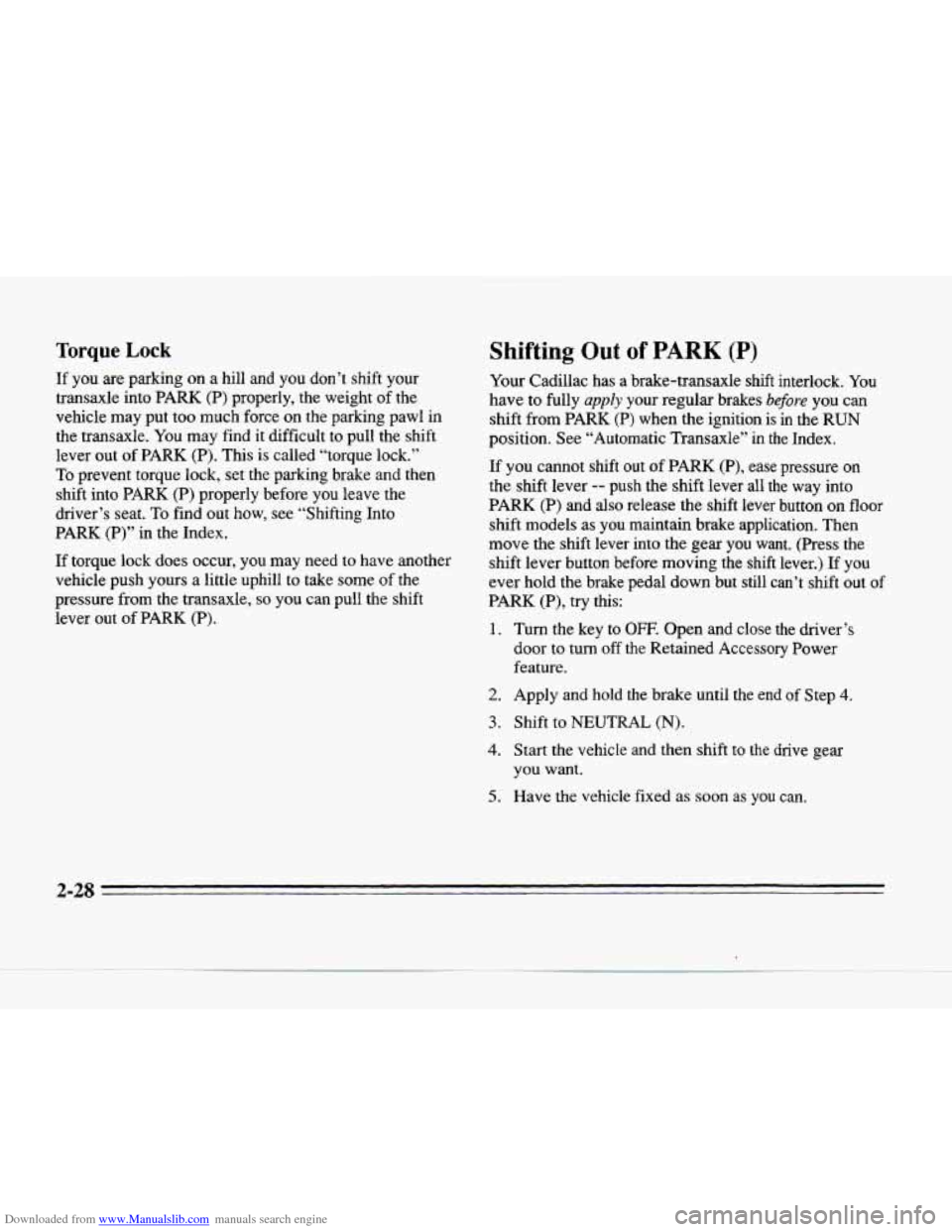
Downloaded from www.Manualslib.com manuals search engine Torque Lock
If you are parking on a hill and you don’t shift your
transaxle into
PARK (P) properly, the weight of the
vehicle may put too much force on the parking pawl in
the transaxle.
You may find it difficult to pull the shift
lever out of
PARK (P). This is called “torque lock.”
To prevent torque lock, set the parking brake and then
shift into PARK
(P) properly before you leave the
driver’s seat. To find
out how, see ”Shifting Into
PARK (P)” in the Index.
If torque lock does occur, you may need to have another
vehicle push yours a little uphill to take some
of the
pressure from the transaxle,
so you can pull the shift
lever out
of PARK (P).
Shifting Out of PARK (P)
Your Cadillac has a brake-transaxle shift interlock. You
have to fully
apply your regular brakes before you can
shift from
PARK (P) when the ignition is in the RUN
position. See “Automatic Transaxle” in the Index.
If you cannot shift out
of PMK (P), ease pressure on
the shift lever -- push the shift lever all the way into
PARK (P) and also release the shift lever button on floor
shift models as you maintain brake application. Then
move the shift lever into the gear you
want. (Press the
shift lever button before moving the shift lever.) If you
ever hold the brake pedal down but still can’t shift out
of
PARK (P), try this:
1. Turn the key to OFF. Open and close the driver’s
door to
turn off the Retained Accessory Power
feature.
c
2. Apply and hold the brake until the end of Step 4.
3. Shift to NEUTRAL (N).
4. Start the vehicle and then shift to the drive gear
you want.
5. Have the vehicle fixed as soon as you can.
2-28
Page 90 of 354

Downloaded from www.Manualslib.com manuals search engine Windows
Power Windows
The controls are located near each window. hess the
control forward
to raise the window and press rearward to
lower. Note that the second rearward position on the
driver‘s control operates the express-down window feature.
Your vehicle has Retained Accessory Power (RAP).
When you stop your vehicle and turn
the ignition key
to OFF, you can still use your power windows. The
electrical power
to operate the windows will not shut
off until you open a door or 10 minutes have passed. If
you want this power for another 10 minutes, turn the key
to
RUN and back to OFF.
Express-Down Window
This feature is present on the driver’s power window.
Pressing the control rearward into the second position
then releasing it will lower the window completely. If
you want to stop the window as it is lowering, press
the control forward. Press the control forward
to raise
the window.
Note that the first position on the control operates the
driver’s power window.
Rear Window Lockout
I Pressing the button
down will disable the
rear passenger window
controls. This is a useful
feature if
you have children
as passengers. Press the
button again to allow your
passengers to
reuse their
window controls.